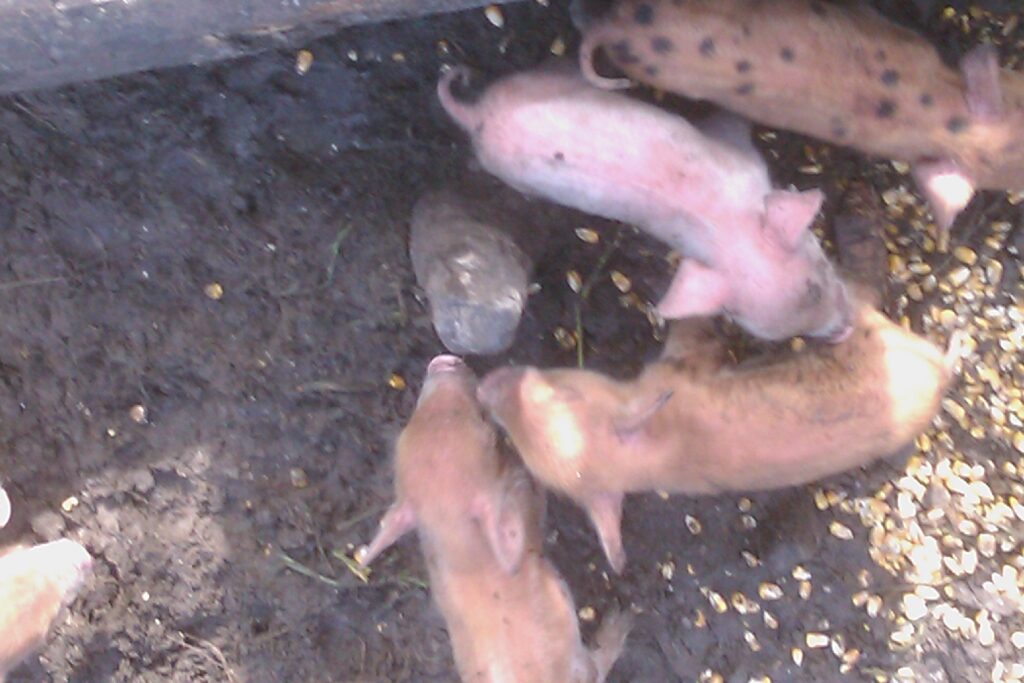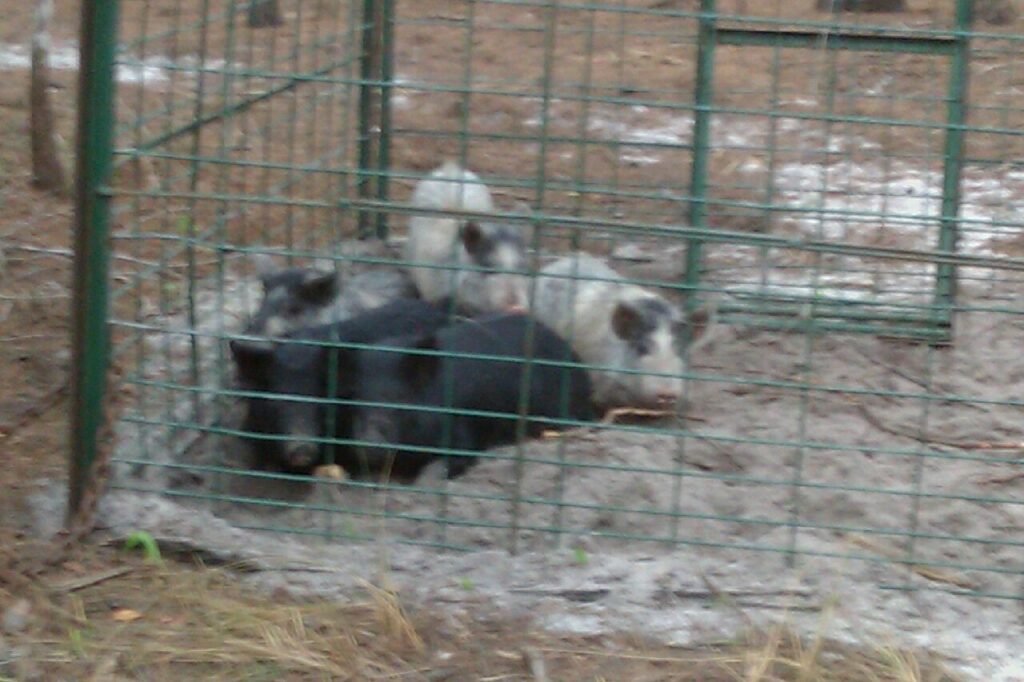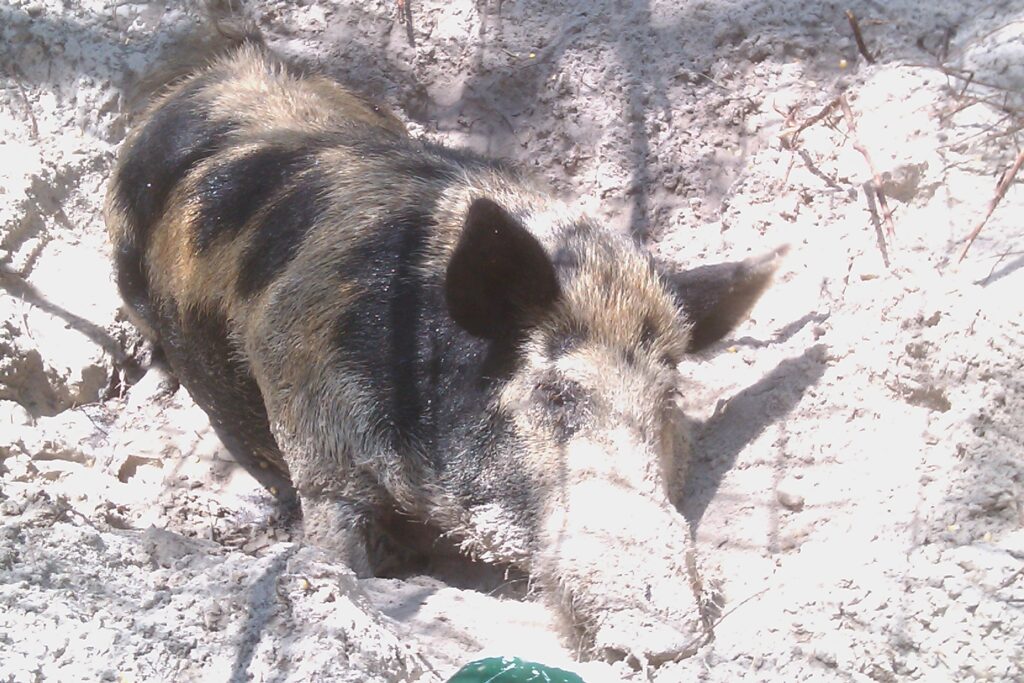
Feral Hogs: (Sus scrofa)
Feral hogs (sus scrofa); more commonly known as wild hogs are species that are of the pig genus sus which are part of the biological family suidae. They average between 5 to 6 feet long, 150 to 200 pounds, standing about 3 to 4 feet tall. Male hogs are called boars and female hogs are call sows after they have produced their first litter.
Their bodies are compact; the head is large and the its legs are relatively short. Its fur consists of stiff, coarse bristles with finer fur. Their color patterns vary from dark grey, brown, black, pink or white, some have marking and some do not. The adult males develop tusks, that are continuously growing teeth protruding from the mouth, from its upper and lower canine teeth. These tusks serve as weapons and tools. The upper tusks are bent upwards in males and are regularly grounded against the lower ones to produce sharp edges. The tusks normally measure 2.4 inches, in some extraordinary cases they can grow to 4.7 inches long.
Females also have sharp canines that are smaller and do not protrude like the males’ tusks. Feral hogs are not native to Florida. They were introduced around 1539 by the Spanish explorer Hernando Desoto. They are now in all 67 counties in Florida, allowing them to adapt to several environments. They have a wide variety of habitats, but prefer oak-cabbage palm hammocks, freshwater, swamps, marshes, sloughs pine-flat woods and residential areas. Feral hogs are so well established, that at the rate they reproduce and their survival skills means unfortunately the population is just about impossible to control. Feral hogs are here to stay.
Feral hogs are usually nocturnal, foraging in the early morning hours, late afternoon or at night, resting for periods during both day and night. They are also omnivorous meaning they eat all kinds of foods, such as plants and animals. Their primarily diet consists of grass, nuts, berries, birds that nest on the ground, roots insects and small reptiles.
Feral hogs usually travel in small family groups that are called sounders or sometimes alone. These sounders typically have about 20 or so animals, although groups of over 50 have been seen. The sounders also contain 2 or 3 sows; of which one will be the dominant female. The adult males are usually solitary outside of the breeding season. The group structure changes with the coming and going of farrowing females. When frightened or concerned they will defend themselves using intense power. The male, lowers their head, charges and then slashes upward with its tusks.
The female, whose tusks are not visible, charges with its head up, mouth completely open and bites.
Feral hogs will breed year round, with the births peeking in spring and the fall. The sow can have 2 litters a year and start mating as young as 8 to 24 months old. The gestational period lasts around 115 days. The sow will leave the group to construct a mound like nest out of vegetation and dirt approximately 1 to 3 days before giving birth. The process of giving birth to a litter lasts 2 to 3 hours. The sow and piglets remain in or close to the nest for 4 to 6 days. The average litter size is typically 4 to 6 piglets but may be smaller for the first litter, usually 2 to 3 piglets. Their largest litters can be up to 14 piglets. After the sows have giving birth, they rejoin the sounders around 4 to 5 five days. The piglets will cross suckle with other lactating sows. The mother sow has completely weaned the piglets by the time they are 3 or 4 months old in which they begin to eat solid foods such as worms or grubs after 1 or 2 weeks.
Feral hogs carry a number of diseases, of which the most common disease being pseudorabies and swine brucellosis. The swine brucellosis disease causes particular concern because an infected hog can transmit this to humans, however they can not be transmitted to humans by consuming the cooked wild meat.
Feral hogs also cause extensive damage to both the environment and agriculturally. They destroy the habitats of native wildlife, by invading and preying on the wildlife and live stock, depleting food sources that other animals need to survive. They also destroy native plant life. The main cause of the destruction is caused by its rooting. In some cases the rooting is so extensive that serious bank erosion has occurred. This could sometimes cause death to fish, by lowering the water quality and possibly force the plant and animal environment to change. Agriculturally their rooting can destroy land, yard, crops and gardens causing significant losses. They can also transmit parasites and diseases to domestic livestock as well as humans. As the population of feral hogs increase, the amount of damage can be devastating.

